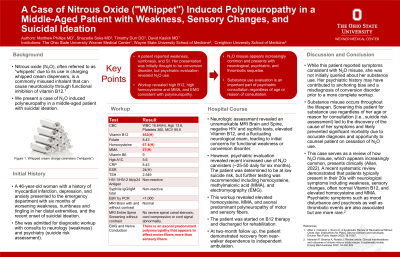Substance Use and Related Disorders
Session: Poster Session
(179) A Case of Nitrous Oxide ("Whippet") Induced Polyneuropathy in a Middle-Aged Patient with Weakness, Sensory Changes, and Suicidal Ideation

Trainee Involvement: Yes

Matthew S. Phillips, MD
Resident Physician
The Ohio State University Wexner Medical Center
Columbus, Ohio, United States
Shazadie Soka, MD
Consultation Liaison Psychiatry Fellow
The Ohio State University Wexner Medical Center
Columbus, Ohio, United States- TD
Timothy Durr, B.S.
Student
A.T. Still University School of Osteopathic Medicine in Arizona
Mesa, Arizona, United States .jpg)
David Kasick, MD, DFAPA, FACLP
Professor of Clinical Psychiatry and Behavioral Health
The Ohio State University Wexner Medical Center
Columbus, Ohio, United States
Presenting Author(s)
Co-Author(s)
Background/Significance: Nitrous oxide (N2O), often referred to as “whippets” due to its use in charging whipped cream dispensers, is a commonly misused inhalant that can cause neurotoxicity through functional inhibition of vitamin B12 (Marsden, 2022). We present a case of N2O induced polyneuropathy in a middle-aged patient with suicidal ideation. Conclusion/Implications: N2O misuse appears increasingly common and presents with neurological, psychiatric, and thrombotic sequelae. Substance use evaluation remains an important part of psychiatric consultation for patients regardless of age or reason of consultation.
Case: A 46-year-old woman with a history of myocardial infarction, depression, and anxiety presented to the emergency department with six months of worsening weakness, numbness and tingling in her distal extremities, and the recent onset of suicidal ideation. She was admitted for diagnostic workup with consults to neurology (weakness) and psychiatry (suicide risk assessment). Neurologic assessment revealed an unremarkable MRI Brain and Spine, negative HIV and syphilis tests, elevated Vitamin B12 (952 pg/mL), and a fluctuating neurological exam, leading to initial concerns for functional weakness or conversion disorder. However, psychiatric evaluation revealed recent increased use of N2O cannisters (approximately 25-50 daily for six months after a long period of abstinence since prior use in her 20s). The patient was determined to be at low suicide risk but further evaluation for N2O misuse was recommended including homocysteine, methylmalonic acid (MMA), and electromyography (EMG). This workup revealed elevated homocysteine (67.4 umol/L), MMA (27 nmol/mL), and axonal predominant polyneuropathy of motor and sensory fibers. The patient was started on B12 therapy and discharged for rehabilitation. At two-month follow up, the patient had ongoing sensory deficits but demonstrated recovery from near-walker dependence to independent ambulation.
Discussion: This case illustrates several valuable points for psychiatric consultants. First, while this patient reported symptoms consistent with N2O misuse, she was not initially queried about her substance use. Her psychiatric history may have contributed to anchoring bias and a misdiagnosis of conversion disorder prior to a more complete neuromedical workup. Second, substance misuse occurs throughout the lifespan. Screening this patient for substance use regardless of her age or reason for consultation (i.e., suicide risk assessment) led to the discovery of the cause of her symptoms and likely prevented significant morbidity due to accurate diagnosis and opportunity to counsel patient on cessation of N2O use. Last, this case serves a review of how N2O misuse, which appears increasingly common, presents clinically (Allan, 2022). A recent systematic review demonstrated that patients typically present in their 20s with neurological symptoms including weakness, sensory changes, often normal Vitamin B12, and elevated homocysteine and MMA. Psychiatric symptoms such as mood disturbance and psychosis as well as thrombotic events are also associated but are more rare (Marsden, 2022).
References:
Allan J, Cameron J, Bruno K: A Systematic Review of Recreational Nitrous Oxide Use: Implications for Policy, Service Delivery and Individuals. Environ Res Public Health 2022; 19:11567.
Marsden P, Sharma A, Rotella J: Review article: Clinical manifestations and outcomes of chronic nitrous oxide misuse: A systematic review. Emerg Med Australas 2022; 34:492-503.

